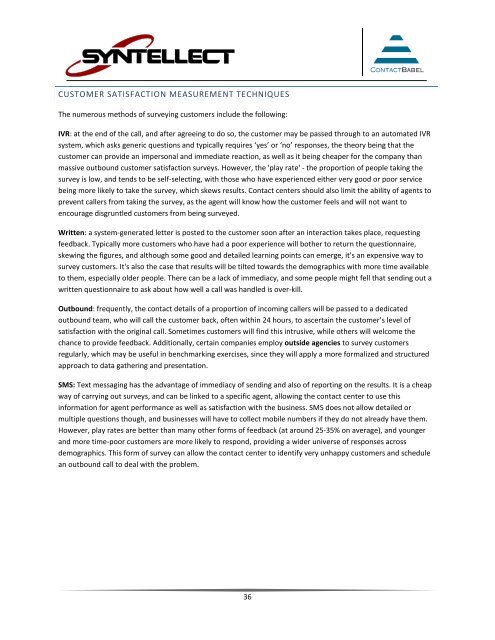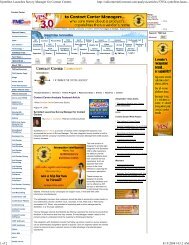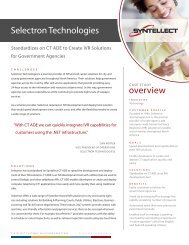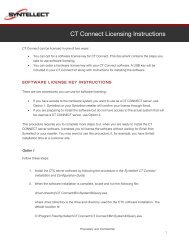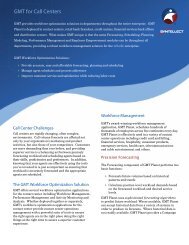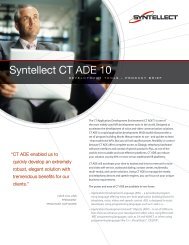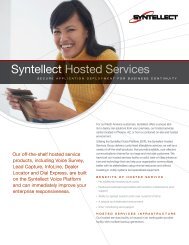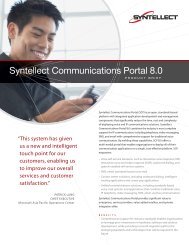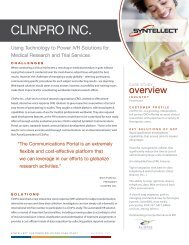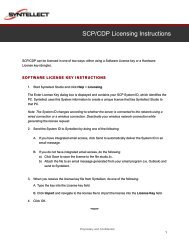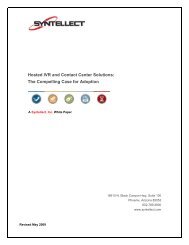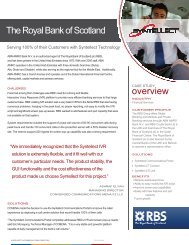2011_ContactBabel - Syntellect
2011_ContactBabel - Syntellect
2011_ContactBabel - Syntellect
You also want an ePaper? Increase the reach of your titles
YUMPU automatically turns print PDFs into web optimized ePapers that Google loves.
CUSTOMER SATISFACTION MEASUREMENT TECHNIQUES<br />
The numerous methods of surveying customers include the following:<br />
IVR: at the end of the call, and after agreeing to do so, the customer may be passed through to an automated IVR<br />
system, which asks generic questions and typically requires ‘yes’ or ‘no’ responses, the theory being that the<br />
customer can provide an impersonal and immediate reaction, as well as it being cheaper for the company than<br />
massive outbound customer satisfaction surveys. However, the 'play rate' - the proportion of people taking the<br />
survey is low, and tends to be self-selecting, with those who have experienced either very good or poor service<br />
being more likely to take the survey, which skews results. Contact centers should also limit the ability of agents to<br />
prevent callers from taking the survey, as the agent will know how the customer feels and will not want to<br />
encourage disgruntled customers from being surveyed.<br />
Written: a system-generated letter is posted to the customer soon after an interaction takes place, requesting<br />
feedback. Typically more customers who have had a poor experience will bother to return the questionnaire,<br />
skewing the figures, and although some good and detailed learning points can emerge, it's an expensive way to<br />
survey customers. It's also the case that results will be tilted towards the demographics with more time available<br />
to them, especially older people. There can be a lack of immediacy, and some people might fell that sending out a<br />
written questionnaire to ask about how well a call was handled is over-kill.<br />
Outbound: frequently, the contact details of a proportion of incoming callers will be passed to a dedicated<br />
outbound team, who will call the customer back, often within 24 hours, to ascertain the customer’s level of<br />
satisfaction with the original call. Sometimes customers will find this intrusive, while others will welcome the<br />
chance to provide feedback. Additionally, certain companies employ outside agencies to survey customers<br />
regularly, which may be useful in benchmarking exercises, since they will apply a more formalized and structured<br />
approach to data gathering and presentation.<br />
SMS: Text messaging has the advantage of immediacy of sending and also of reporting on the results. It is a cheap<br />
way of carrying out surveys, and can be linked to a specific agent, allowing the contact center to use this<br />
information for agent performance as well as satisfaction with the business. SMS does not allow detailed or<br />
multiple questions though, and businesses will have to collect mobile numbers if they do not already have them.<br />
However, play rates are better than many other forms of feedback (at around 25-35% on average), and younger<br />
and more time-poor customers are more likely to respond, providing a wider universe of responses across<br />
demographics. This form of survey can allow the contact center to identify very unhappy customers and schedule<br />
an outbound call to deal with the problem.<br />
36


